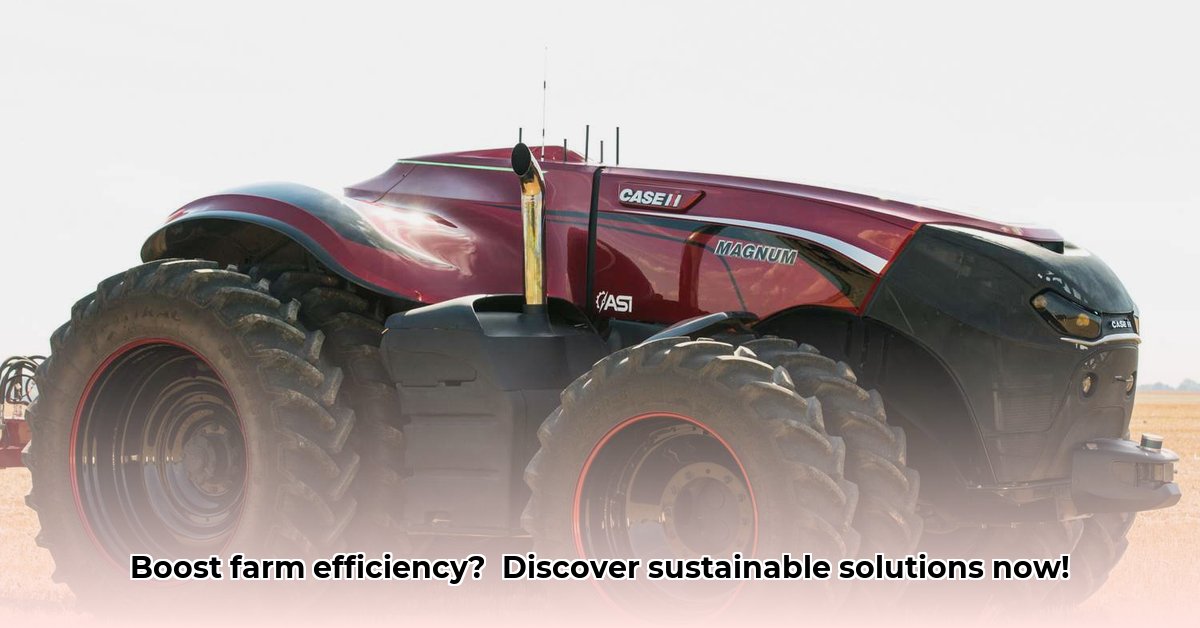
Case IH Tractors: A Comprehensive Review of Efficiency and Sustainability
Choosing the right tractor is a critical investment for any farm. This detailed review analyzes Case IH tractors, focusing on their efficiency and sustainability, providing actionable insights for farmers, businesses, and policymakers. While Case IH presents itself as a leader in sustainable agriculture, a thorough examination is needed beyond marketing claims. This analysis considers fuel efficiency, productivity enhancements, lifecycle costs, and environmental impact. For more detailed Case IH tractor specifications, visit the Case IH website.
Fuel Efficiency and Operational Cost Analysis
Fuel costs represent a substantial portion of farm operating expenses. Case IH highlights the fuel efficiency of their tractors, but independent verification of these claims is crucial. Quantifiable data comparing fuel consumption per acre across different Case IH models and competing brands is needed to assess their true fuel efficiency. Without this comparative data, any claims remain unsubstantiated. How much real fuel savings can a farmer expect? This is a critical question requiring concrete data analysis. For instance, a graph visualizing fuel consumption (gallons/acre) across multiple tractor brands would offer far greater insight than general marketing statements.
Productivity and Precision Farming Technologies
Case IH tractors incorporate features designed to maximize farm productivity. These include user-friendly controls, precision farming technologies optimizing input usage (fertilizer, seed), and automation functionalities. Quantifying the impact of these features on yield is vital. For farmers, the crucial question isn’t about features, but about results. Real-world data demonstrating the yield increase achieved using Case IH's precision farming technology compared to traditional methods would significantly strengthen their value proposition. Comparing yields (bushels/acre) with and without these technologies would provide a clear, objective measure of their effectiveness. Are these productivity enhancements substantial enough to justify higher initial investment costs? This is a decision farmers need to make, based on sound, verifiable data.
Lifecycle Cost Analysis and Environmental Impact
Sustainability extends beyond fuel economy to encompass the entire lifecycle of a tractor. A complete cradle-to-grave assessment, including manufacturing, usage, maintenance and disposal, is necessary to gauge the environmental impact. Transparency is paramount. A detailed breakdown of lifecycle costs—initial purchase price, maintenance, fuel, and resale value—is essential for effective decision-making. This necessitates a comprehensive comparison against competing brands incorporating environmental factors like greenhouse gas emissions. How do Case IH's lifecycle CO2 emissions compare to those of competitor tractors? Independent, verifiable data on this crucial aspect is currently missing.
Stakeholder Actions for Sustainable Agriculture
The path towards sustainable agriculture requires collaborative action from various stakeholders:
| Stakeholder Group | Short-Term Actions | Long-Term Actions |
|---|---|---|
| Farmers/Ag Businesses | Conduct thorough comparative analyses of fuel efficiency and operational costs for Case IH and competing tractors. Explore various financing options. | Conduct a full lifecycle cost analysis, including environmental impact assessments. Invest in precision farming technologies to maximize efficiency. |
| Case IH | Publicly release independently verified data on fuel efficiency and the full environmental footprint of their tractors. Publish detailed sustainability reports. | Invest heavily in R&D focused on improving fuel efficiency and exploring alternative fuel options. Develop a user-friendly lifetime cost calculator for consumers. |
| Government/Regulatory Bodies | Implement tighter emission standards for agricultural equipment. Offer incentives promoting fuel-efficient technology adoption. | Encourage research into sustainable agricultural practices. Fund the development of innovative farming technologies. |
Calculating the Lifecycle Cost of Case IH Tractors: A Practical Guide
Key Takeaways:
- Resale value significantly impacts the overall lifecycle cost. Brands with strong reputations generally retain higher resale values.
- Dealer support network reliability directly affects downtime and repair expenses.
- Total cost of ownership (TCO) is far more important than the initial purchase price. This includes maintenance, repairs, and fuel expenses.
- Comprehensive financial modeling is crucial for accurate lifecycle cost calculation across different tractor brands.
- Implement costs should be factored into the total lifecycle expenses.
Step-by-Step Lifecycle Cost Calculation
- Data Collection: Gather initial purchase prices from dealerships for Case IH and competitor tractors.
- Operating Cost Estimation: Project annual fuel use based on usage and efficiency. Include costs for maintenance, repairs (possibly using data from dealer reviews), and insurance.
- Resale Value Projection: Research resale values of comparable models after a specified period (e.g., five years) using used equipment websites.
- Depreciation Calculation: Subtract projected resale value from the initial purchase price.
- Annual Cost Summation: Add annual operating costs.
- Total Cost Determination: Sum initial price, annual operating costs, and depreciation for the TCO.
- Comparative Analysis: Repeat for all brands to compare TCO over the chosen timeframe.
Integrating Sustainability into the Decision Making Process
Sustainable practices are crucial in modern agriculture. Factor in fuel efficiency, impact on soil health, and the environmental footprint of manufacturing. A tractor's lifecycle CO2 emissions are a critical sustainability metric. These factors can influence a farm's long-term economic viability.
Conclusion: A Data-Driven Approach to Tractor Selection
The choice of tractor should be based on a thorough, data-driven cost analysis, considering both short-term and long-term impacts. While initial savings might be tempting, the total cost of ownership needs careful consideration. Only through a comprehensive analysis, including independent verification of efficiency and environmental impact data, can farmers make informed decisions that benefit both their bottom line and the planet.